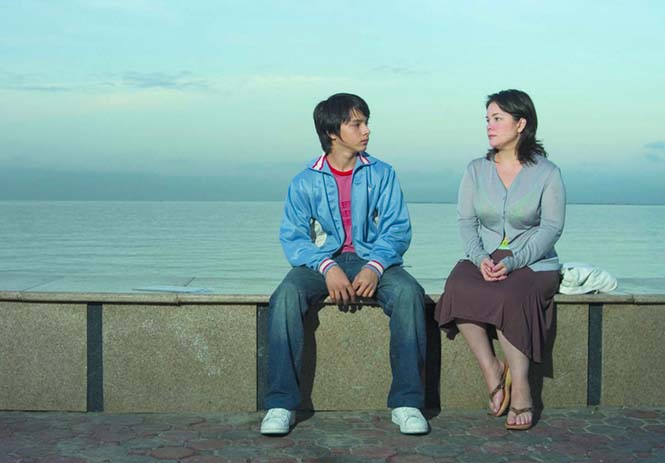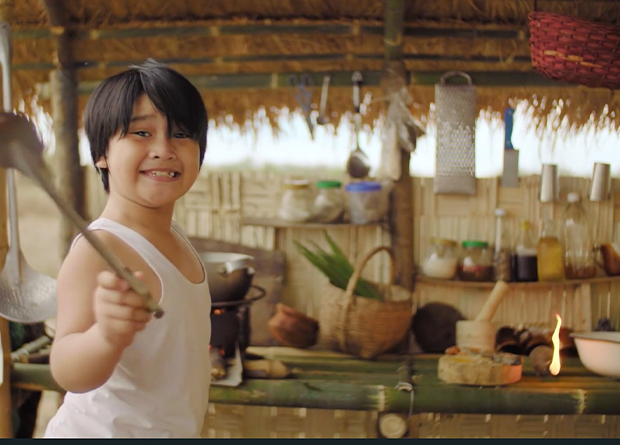Oh. My. God.
And I don’t say that lightly, considering I am agnostic.
But this film makes you call out for some divine intervention. But not – mind you – because it’s good; but because it is so, so, so… horrible you just want it to already end.
This sounds harsh, yes; but as I always say, we all need bitches in our lives; artists – including filmmakers – more so because they need someone honest in their lives to tell them the hard truths about their outputs/to tell us what works or not. Otherwise we deliver something shitty it is bound to get eviscerated. And seriously, this one deserves gutting.
Let me try, therefore, dissecting Ani (The Harvest) by Kim Zuñiga and Sandro Del Rosario.
WHAT IT’S ABOUT
This is, BTW, a coming of age story (a gist, if you must) for this not-too-young boy (still aberrantly babied by his parents) whose transition into adulthood was helped by a robot.
The story is supposed to be “simple” enough. Sometime in the near future, a boy (Zyren dela Cruz) is abandoned/left by his father (Marc Felix; some rebel whose cause we never really got to know deeply, and so we don’t really care about) and his mother (Anna Luna; who died in front of him – though not after compulsorily singing him his lullaby just because the directors “wanted to have a lullaby in the film,” as the directors themselves told me). So this boy – Mithi – was taken by a deadpan social worker to his grandfather (Ricky Davao) who lives in a farm (but is, apparently, also a rebel who doesn’t want to sell his non-productive land to a mall-builder).
Many a site will give you a different synopsis for this film – e.g. “When his grandfather falls ill, an orphaned boy and his malfunctioning robot embark on a quest to look for magical grains that he believes will save the old man’s life.”
But this is NOT clear-cut in the film.
Instead, we see this attempt to be a sci-fi film a la A.I., Ready Player One, Chappie and so on; and this attempt to be fantastical a la Pan’s Labyrinth and perhaps even Cinemalaya 2018 entry Liway; and an attempt to… appear like a Lysol ad (or even like Maine Mendoza and Boy Abunda’s ad for Hygienix Germicidal Soap; the effects are about the same, so there’s nothing “groundbreaking” here).
And so the film stumbles. A lot. Many times. And BIG time.
WHY WATCH IT
When the film was intro’d during its gala in Cinemalaya 2019, the directors expressed happiness since tix for this flick were selling like hot pancakes. Perhaps not surprisingly, considering that – a reason to attempt to see this – this is the first sci-fi film in Cinemalaya’s history. And considering the world’s penchant for sci-fi, this isn’t really a surprise…
The actors in the flick weren’t all that bad, either – I mean, he may be too old for his role, but Dela Cruz can shed tears a la Maricel Soriano/Judy Ann Santos; you get eye candies like Raphael Robes (in a, shall we say useless, trophy-giving role); and you get an ultra-tisoy farmer like Davao.
But then… I am hard-pressed finding anything else good to say about this flick…

WHAY AVOID IT
Now let me count the ways why this film is a hard pill to swallow for me.
First: The story is lame.
As earlier noted, it doesn’t really know what it wants to be (aside from the umbrella “sci-fi film”). And so we get a (supposedly grim) story from the future (the directors told me as much, too; that this is a “message” for us from the future), told via the coming of age of Mithi, injected with other not-fully-developed storylines (like the rebellion, the search for those magic seeds, the benefits of farming, and so on). In last year’s film fest, I thought The Lookout was already a tortuous film. Well, this one’s there with it…
Second: The small budget can be seen in everything, from the horrible set design (e.g. Xmas lights in the boy’s room; fake windows that move when the actors moved; and those pasted-on-the-wall pipes to make them look “industrial” and “futuristic”); the costume design (e.g. silk vest to signify futuristic; and “normal” rural clothes to signify the provincial); and the effects (more on this on the next point)…
Third: The bad effects.
You would immediately see this when you look at those moving windows early on in the film. And then there are those buildings mimicking Ready Player One, though here, they were just designed as such, no explanations given on why (considering humanity still had parcels of land to use – e.g. the grandfather’s farm). And then when the robot finally appeared, I was reminded of Ate Vi’s Darna flicks. Remember how they made her “fly”, by “pasting” a clip/pic/shot of her pretending to “fly” on another shot? This effort gave us that shiny pixelation around the flying Darna. And you get that here, too (though not as apparent) – this too-apparent segregation with what’s real and what’s fake (e.g. when the robot hugged the boy, when they “danced”). And it disrupts the storytelling.
Fourth: Already bad story also badly told.
There are scenes that bug me. Big time.
For instance, when the grandfather had a stroke (or something), what did the kid do? Went to some junkyard to sell his dead mother’s golden necklace. He did not go to the neighbors; not his relatives (who also live nearby); not a clinic/hospital; and not even that social worker who told him to give her a call if he needed help. He went to this junkyard to sell his mother’s necklace (with his robot in tow).
This is the future so the farms are tended by robots (you see them in the background in some scenes). And then… the gramps has a carabao, and he also plants the rice by hand (?). The flick just can’t make up its mind…
The boy kept his robot in a shed on this pathway in some forest near his house/school; and yet not a single soul saw it there (and considering that the same forest is rebel-infested).
The boy took his robot to school. Right in front of the owners of the robot. It even clapped its metal heart out when the boy won. At that time, not one soul gave a damn. And then in another scene, the same people who were face-to-face with the robot told the boy to “Give us back our robot!”?
As I said, everyone needs a bitch in their circles; one who would tell them the honest/brutal truth. I’m not sure one such bitch existed in the making of this flick; so we get this convoluted output…
Fifth: No one cares about the characters.
The people behind the flick seemed to be more concerned with the “first sci-fi in Cinemalaya” title than telling a story that matters.
For instance, that we’re being swamped by malls is a worthy narrative in its own; but we don’t even get to know why this is bad (or good). The father is a rebel against MNCs (and so are the relatives); but… what’s he doing in the “resistance”, and what – exactly) are they fighting for? No more malls? The mother (whose make up was badly done) was so sick she died at home; but… what was she even sick of? How sick was she again? Then there’s the robot that “cared” about its human; but… how did this “warbot” become humane again (don’t expect an I, Robot explanation here)?
Not one of the characters was well-developed; and with this detachment, we really just couldn’t “feel” the flick…
Sixth: Ripping off is – plain and simple – horrible. Particularly when the retelling is this bad.
Everything this flick wants to tell isn’t fresh…
Pan’s Labyrinth showed us that we can tell a “heavy” story via a child’s fantastical perspective. Heck, even Liway had a go at this and succeeded somehow (well, based on its earnings).
Chappie already told the story of a bad-robot-turned-good to help save people it loved. It bombed in the box office (at least in Hollywood standards), but it gave us this narrative already anyway. Heck, even “Small Wonder” (an American comedy science fiction sitcom that aired from 1985 to 1989) did it better.
The likes of the Muppets (Rainbow Connection) and Wizard of Oz (Somewhere Over the Rainbow) and Breakfast at Tiffany’s (Moon River) already showed us how a single song can help define a film. But they, at least, gave us something… memorable.
Ready Player One already gave us this “search for a special item” narrative (via sci-fi approach). Arguably, they had gazillions to spend. But exactly because they already told the same tale with gazillions to spend, those who attempt to re-tell should bring something new to the table; and this film just didn’t…
Elysium and Alita (among hundreds) already tackled this “MNCs taking over the world” narrative, and they, too, had gazillions to spend when they told their stories. Again, retelling is okay; just be sure you do so with something… new.
Aside from directors Kim Zuñiga and Sandro Del Rosario, others involved in the film mere:
Screenplay: Toni Zuñiga, Kim Zuñiga, and Sandro Del Rosario
Cinematography: Alex Uy
Production Design: Verna Ignacio, Darwin Ignacio, Raedag Villamin
Editing: Kim Zuñiga and Sandro Del Rosario
Original Music Score: Vince Lim
Sound: Andrew Millalos
2D Animation Director: Cholo Katipunan
Visual Effects Producer: Sixto Del Rosario
IN THE END
If you’re looking to see the “first sci-fi film in Cinemalaya”, then watch this.
If you are perhaps friendly to people in the film and want to support them, then watch this.
If you want to show your support to the young who helped make this film happen by giving them an “okay lang ‘yan for your first effort” pat on the shoulder, then watch this.
But if you aren’t any of the three, spend your money on the other more deserving films. If you really, really insist, then go ahead and watch (that is always your call); but we’ll be outside the cinema, counting the (growing) number of people we saw who actually walked out while watching this flick…




























































































